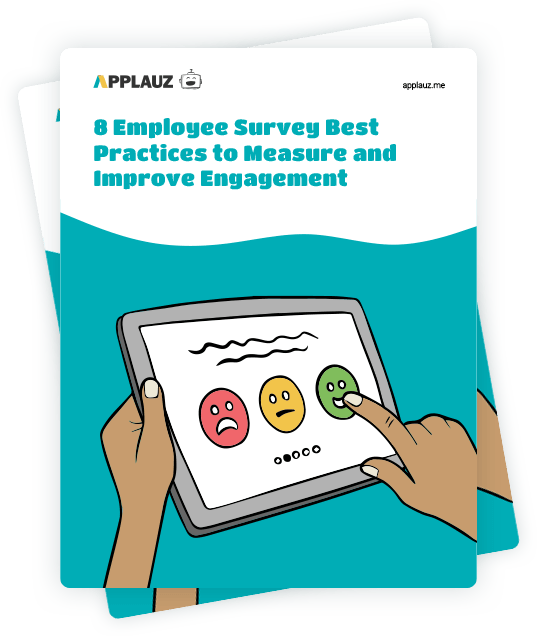The employee engagement playbook we’ve used for years might no longer be enough.
Partly driven by emerging hybrid and remote work structures, companies worldwide face challenges in driving and evaluating employee engagement, particularly amidst soaring labor costs and declining productivity. Of course, this carries enormous implications for your company's talent-management strategy and financial performance. Engaged individuals demonstrate higher productivity and maintain better health, resilience, and a greater likelihood of remaining with the company.
As you read this, businesses are grappling with a wave of resignations as employees, feeling burnt out and overwhelmed, ponder their work roles. They're questioning how much their employers truly appreciate them and considering their options—more often than you might think. It's exactly at this juncture that the most forward-thinking and strategic companies can step up, providing an outstanding employee experience by authentically recognizing and responding to the needs and feelings of their workforce.
Think about it this way: delivering exceptional employee experience is more than just empty rhetoric; it demands a fundamental shift from the standard top-down structure to one that revolves around empathy, ideation, and prototyping. Are you prioritizing your staff by understanding and addressing their unique employee journeys? Are you implementing interventions that focus on pivotal moments to enhance satisfaction, performance, and productivity? What initiatives are in the pipeline to craft a meaningful and enjoyable experience for your workforce?
When thinking about employee experience, you need to appreciate the diverse range of what individuals find valuable. Consider the influence of their life stage, personal circumstances, and even personality types on the appeal of various offerings. Contrary to common belief, the most motivating solution often extends beyond a simple boost in pay. What employees truly desire is a strong sense of agency – the power to shape outcomes that matter personally – coupled with a deep sense of identity and belonging. This means not just having control over the work itself but also having influence over one's own contributions.
And how do you apply this human-centred mindset? Well, you can start off on the right foot with an employee survey infused with empathy, ensuring each question reflects a genuine understanding of the challenges and joys your employees face in their roles. Focusing on capturing the perspectives, concerns, and preferences of staff members, surveys need to ask targeted questions that delve into the intricacies of the employee journey, uncovering a nuanced understanding of what matters to individuals.
The result? You not only gain a deeper understanding of your personnel but also get valuable insights that will help you create unique and customized opportunities to further your understanding of the motivations of your employees.
8 Employee Survey Best Practices to Measure and Improve Engagement
 Why Employee Surveys Matter
Why Employee Surveys Matter
At their core, employee surveys are essential tools for companies seeking to understand and transform their work culture, productivity, and overall success.
Research has shown that traditional engagement surveys fall short of capturing modern employees' nuanced needs and desires. Just as you would measure finances or sales, you need to leverage surveys in real-time, making employees active participants in positive change.
Firstly, employee surveys enable proactive problem-solving. By continuously checking the "temperature" of the work culture, you can identify and address issues before they escalate. This preventative approach helps maintain employee retention and avoids sudden drops in productivity and sales.
Secondly, surveys lay the groundwork for empathy and trust. Both leaders and employees benefit from ongoing feedback, turning communication into a two-way process. Open feedback encourages leaders to ask meaningful survey questions about the company's mission and vision, building trust and improving workflow. And if you’re noticing disconnected team members, you can re-engage them through meaningful conversations, all while demonstrating care for their concerns.
Surveys also offer opportunities for improvement, especially when using employee-preferred measurement tools. Encouraging staff to express their thoughts regularly incentivizes engagement and delivers valuable insights for continuous improvement.
Many solutions also offer meaningful analytics that connect every element of your employee engagement program, providing a comprehensive overview. For instance, Applauz distills pulse survey data into easy-to-read dashboards, illustrating the level of happiness among your employees at work and demonstrating how their satisfaction changes over time. Most importantly, it highlights areas of your employee experience that require urgent attention.
If you want to facilitate a positive flow within your organization, regular monitoring and the continuation of successful engagement initiatives are the way to go. A workplace where workers feel valued and connected is what drives your company toward sustained success.
 Types of Employee Surveys
Types of Employee Surveys
It's clear why employee surveys have stood the test of time across generations of workforce changes, yet the specific surveys administered have had to evolve over the years.
Let’s explore the typical survey formats commonly used across a wide range of businesses:
Traditional Annual Surveys
Annual employee surveys are a great tool for your leadership to gather feedback and assess employee engagement, morale, and performance - and that’s why they’ve endured.
Typically comprising at least 50 questions, these surveys focus on employees' feelings about various aspects, including working conditions, management, motivation, job satisfaction, compensation, benefits, company policies, diversity, turnover, and retention. They are designed to provide a comprehensive overview of business topics, measure emotional commitment, and support cohesive change.
By assessing factors such as resource availability, role support, workload, recognition, empowerment, growth opportunities, and collaboration, you’re able to collect valuable data for analysis. When well-designed, these surveys offer statistical validity, enabling you to make informed decisions for large-scale changes and improvements. Despite their potential benefits, criticisms surface due to their length and the challenge of maintaining employee interest and engagement throughout the process.
Pulse Surveys
A pulse survey is a short series of questions (often completed within 5-10 minutes) conducted relatively frequently, designed to track responses to an issue or topic over a designated period. Employee pulse surveys are usually completed online, offering participants the choice of answering questions on a computer or mobile device. The quick and easy nature of pulse surveys leads to greater participation, survey completion and stronger, more reliable results. Pulse surveys also allow for streamlined data collection and timely analysis of results so you can respond to feedback quickly.
Pulse surveys have become popular in recent years as they provide employers with a valuable tool to swiftly gauge and respond to their workforce's evolving needs and sentiments, all in real-time. Employers can stay attuned to employee experiences, facilitate a more responsive and inclusive workplace culture, and make quick, informed decisions to enhance overall employee engagement and satisfaction — whenever necessary.
Leaders who understand the significance of pulse surveys recognize them as the key to unlocking greater employee participation. While traditional employee engagement surveys typically secure a response rate of 30-40%, pulse surveys consistently achieve an outstanding 85% response rate.
Robust pulse survey technologies, such as that offered by Applauz--make it even easier to reveal the pain points of your unique workforce. It's your best bet to unlock the full potential of your HR strategies and customize incentives to align with your employees' goals.
After all, data-driven HR has become a staple across the modern workplace. By utilizing third-party software such as Applauz for evaluating employee satisfaction, engagement, and productivity, you can tailor everything from recruitment strategies to employee experiences and retention initiatives—ultimately reducing turnover and attracting top talent.
Onboarding Surveys
Onboarding surveys are instrumental in understanding and improving the initial experiences of new hires. By capturing impressions, expectations, and early feedback, you can tailor their onboarding processes to better meet the needs of each new staff member. This typically culminates in higher retention rates, faster integration into the company culture, and a positive impact on overall employee satisfaction. Addressing concerns raised in onboarding surveys allows you to refine your onboarding programs and set the stage for long-term employee success.
Stay Surveys
To avoid being left with high turnover, you must acknowledge the valuable talent that you already have and make sure they feel like they are important so they don’t feel forced to look elsewhere.
This is your opportunity to dig deeper into why key personnel remain with your organization and identify triggers early that may prompt them to consider leaving. These surveys seek to preemptively address concerns, uncover factors that contribute to employee satisfaction, and assess engagement levels. By asking targeted questions, stay surveys not only reveal why key talent stays, what they appreciate, and areas for improvement but also help identify members at risk of resigning and reasons why competitors may be appealing. Additionally, they contribute to a sense of value and importance among employees, fomenting stronger loyalty and commitment to your business.
Exit Surveys
An exit survey, taken at the end of an employee’s time with you, is the best way to find out at scale why people leave your organization. You can identify trends, learn from them, and take action to reduce attrition, such as more robust hiring strategies for new team members or improvements to your company culture, working practices, and management styles.
Exit surveys gather honest feedback and clarity into the reasons behind an employee’s departure. Serving as an opportunity for post-departure feedback that can contribute to ongoing company improvement, this is a chance to learn from leavers’ experiences – the good and the bad. Ideally, exit surveys are supplemented with one-to-one interviews to get the full and honest picture.
Employee Engagement Surveys
An employee engagement survey is a tool used to measure and understand employee engagement levels. Conducted throughout the year, these surveys involve all employees to reveal employee perceptions and turn them into actionable insights. Covering a broad range of factors, including job satisfaction, communication, leadership, and growth opportunities, they help measure the strength of the emotional and mental connection team members feel toward their work, team, and the organization as a whole.
Employee Experience Surveys
Employee experience surveys take a broader look at the entire journey of an employee within the organization. This type of survey examines every touchpoint an employee has with the company, from their onboarding experience to exit, including their physical work environment, the tools and resources available to them, their relationships with management and colleagues, and their growth and development opportunities. The goal is to identify strengths and weaknesses in the overall workplace experience, which can affect not only engagement but also retention, recruitment, and performance.
 Benefits of Conducting Employee Surveys
Benefits of Conducting Employee Surveys
Though employee surveys are one of the most valuable tools, they are also among the most underutilized. Surveys can be conducted using a variety of techniques, from traditional paper surveys to online surveys. Even surveys offered by a third-party platform can be useful. Regardless of which methodology your company uses, taking this step is a move in the right direction when it comes to better understanding the needs of your team.
Here are some tangible benefits of employee surveys:
Improved Retention Rates
The main reason why employees walk out is that they feel that their strengths are not fully utilized, they do not feel challenged, or they do not enjoy their work. These are all signs of low engagement.
To avoid high turnover, employers need to conduct employee engagement surveys to detect if an employee is likely to leave the organization early on. The insights offered by surveys allow employers to make the right decision to ensure that the team is engaged and does not look elsewhere for work.
It is more cost-effective to retain employees and take steps to ensure satisfaction than to become complacent, as high turnover levels can prove costly for your business.
It can be extremely expensive for employers to rehire, retrain, and restructure employees. Hence, employers need to put in the effort to make sure employees are engaged and less likely to leave.
Enhanced Employee Engagement
Unlike happiness or satisfaction, employee engagement is characterized by a deep connection to your organization's goals and a genuine interest in its success. Engaged employees go beyond collecting a paycheck; they actively contribute to the company's success and show care for their colleagues. The benefits of high employee engagement include increased productivity, collaboration, camaraderie, and employees going the extra mile to achieve company goals.
As per a 2022 Gallup study, only one-third of employees in the US are currently engaged at work. Employee surveys focused on engagement become crucial tools to identify areas requiring improvement. These surveys allow companies to enhance specific aspects, leading to an overall increase in employee engagement. By asking targeted questions in these surveys, you can delve into areas such as job satisfaction, commitment to company goals, and overall morale, gaining actionable insights to foster a more engaged and motivated workforce.
Targeted Decision-Making
Employee surveys serve as a valuable asset for informed decision-making within your business.
As per Forrester, survey data contributes significantly to business growth, with companies effectively deploying and sharing data insights experiencing over 30% annual growth. The insights derived from survey data are particularly beneficial for various departments, including marketing, human resources, and customer experience teams. Unlike traditional data sources, surveys provide a more nuanced understanding of employees, answering the "why" behind actions and feelings. Integrating survey feedback into existing systems, collecting feedback throughout the employee journey, sharing survey data across departments, and securing controlled data management contribute to creating conditions conducive to data-driven decision-making. This approach not only aligns you with changing needs but also improves team performance, competitiveness, and overall success.
Positive Company Culture
Employee surveys contribute to a positive company culture by providing valuable insights into operational dynamics and employee sentiments. These surveys help you understand how team members perceive internal values, ethics, and organizational rules. The importance of these surveys lies in their ability to uncover areas for development and improvement, facilitating a work environment that retains existing personnel and attracts new talents.
Ideally, the surveys should be designed to evaluate various aspects of corporate culture, including strategic direction, trust in management, productivity, quality of work, manager effectiveness, employee engagement, and considerations related to the pandemic and work environment. By aligning the company's actual culture with its promoted values and ethics, you can strengthen strategic decision-making, future investments, and systemic changes, among other things.
Increased Productivity
Employee surveys create a pathway for open communication, nurturing a culture of transparency and collaboration within companies. By actively soliciting feedback from employees, companies demonstrate their commitment to understanding their needs, leading to enhanced morale and engagement. Addressing concerns highlighted in surveys allows you to implement targeted improvements, resulting in a more efficient and gratifying work environment. Additionally, when team members feel heard and appreciated, their motivation, commitment, and investment in the success of the business are likely to increase. This heightened engagement directly contributes to higher productivity, as workers are empowered to contribute their optimal efforts and innovative ideas, ultimately driving the overall success of the company.
Incentivizing Participation
When employees feel a genuine connection to the survey process, it transcends mere participation. It becomes a shared journey, a collective effort to shape the very fabric of the workplace. Their buy-in signifies a commitment to transparency and openness, a recognition that their insights hold power to mould the organization's trajectory.
In a workplace where buy-in thrives, surveys cease to be mundane tasks and transform into meaningful conversations. Team members understand that their feedback isn't lost in the void but serves as a compass steering your business towards continuous improvement. It's an acknowledgment that their voices echo beyond the survey itself, influencing tangible changes that can be implemented throughout the entire workplace.
Finally, participation involves belief: a belief that providing feedback will benefit the company, its customers, and its employees individually. Assessing the survey through the "what’s in it for me" lens through which team members view leaders must ensure they thoroughly address the workforce’s concerns and uncertainties. A clear understanding of one’s role in providing feedback also helps cultivate a sense of ownership: people can see how their insights fit into the bigger picture and how their feedback contributes to the overall success of the organization.
 Types of Survey Incentives
Types of Survey Incentives
To foster robust employee survey participation, you need to implement a multifaceted approach to incentives.
Group incentives prove effective by offering rewards to teams or workgroups, achieving high response rates, promoting camaraderie, and encouraging mutual reminders to take the survey. Individual participation can be encouraged through modest incentives, such as entry into a prize draw for each completed survey, keeping a balance between appeal and thoughtfulness. You can even align incentives with your unique culture, with options like prime parking spots or bonus PTO days reflecting meaningful recognition.
Playful elements like digital scratch cards and leaderboards add an engaging touch, while signature practices, like celebrations and retail gift cards, can make the survey experience memorable.
There are also tools available--like Applauz--that enable both managers and staff members to acknowledge each other's accomplishments by awarding Points for a job well done. You can easily set a budget-friendly amount of Points to empower your team to recognize and reward their peers. These Points seamlessly integrate into a system that unlocks personalized Employee Perks as a token of appreciation.
Many companies also reward the completion of weekly pulse surveys. It's a fantastic way to infuse positivity and recognition into your workplace culture!
 Guaranteeing Confidentiality
Guaranteeing Confidentiality
Embrace frameworks like clear communication on confidentiality to establish trust among your employees.
Your workforce requires full assurance, freedom, and security to submit honest opinions without having to worry about potential consequences and being reprimanded by their managers. That’s why your leadership needs to communicate that the survey is completely anonymous, fully inclusive of all company employees and offers a safe platform that allows their opinions and feedback to be communicated upward. Some employees may be afraid to speak up at work. If they sense that candid feedback will be received unfavourably, they must be reassured that their responses will be kept completely confidential.
In the first survey, it's crucial to recognize the significance of confidentiality as employees understandably worry about maintaining their anonymity. Take the time to assure them that the survey results will only be discussed when combined with input from their team or department, never on an individual basis. This way, they can feel confident that their feedback remains confidential and won't lead to personal identification.
Thinking about keeping your workforce engaged throughout the survey process is useful. Engagement, after all, is fluid, responding to peoples’ changing circumstances. Adopting that mindset and approaching survey participation as an ongoing process, not a static endpoint, will help survey leaders collect more meaningful and actionable insights.
 Best Practices for Successful Employee Surveys
Best Practices for Successful Employee Surveys
Encouraging your employees to join surveys goes beyond just offering incentives; it's about approaching the entire process with a thoughtful strategy. When crafting the surveys, think about the content, length, and how often they are delivered. Every step, from the design phase to putting the surveys into action and considering the outcomes afterward, contributes to their success.
It's not just about getting responses; it's about creating an experience that engages and resonates with your team members, making their input incredibly valuable.
Survey Design
Crafting an effective employee survey begins with setting clear objectives. Clearly define what you aim to achieve with the survey to guide the design process. Make certain that your questions are direct, avoiding ambiguity to elicit specific and valuable responses. Maintain a balanced mix of employee survey questions covering various aspects of the employee experience. The survey should be user-friendly, with an intuitive layout to encourage maximum participation. Most importantly, ensure anonymity to cultivate an environment where employees feel safe sharing candid feedback.
Implementation
A well-designed survey is only as effective as its implementation strategy.
Here are some guidelines for designing employee surveys that you can put into action yourself or see firsthand by using an employee survey solution.
Use the Likert Scale
Making your survey questions easy to answer is key to boosting employee responses, and the Likert scale is an exceptionally straightforward tool. With a range from "strongly disagree" to "strongly agree," this 5-point scale offers simplicity in producing easily measurable data. It surpasses binary yes/no or true/false questions by offering more nuanced insights. You can even enhance the user experience by incorporating visual representations for each point on the scale, empowering the team to quickly choose the response that best reflects their sentiments.
Include Some Open-Ended Questions
In addition to binary questions and those using the Likert scale, include some open-ended questions and allow team members to express what they feel in their own words. These might touch on areas the employee would like to see addressed in future surveys or ways the team member’s experience could be improved. You can provide the option to leave comments on other questions as well, which often provides useful context when analyzing survey results.
Ask Short Questions Aligned With Your Goals
Regardless of the structure of your questions, maintain clarity and alignment with your survey objectives. If assessing the efficacy of your recognition program, craft questions directly linked to the key performance indicators (KPIs) used for measuring success. Should burnout be a prevailing issue, focus on probing into all related contributing factors. Conducting surveys that efficiently address your current informational requirements is not only more digestible for employees but also more advantageous for your company.
Keep It Anonymous
Anonymous surveys are a must. When staff understand that leaders and HR could link their feedback to them, they may be hesitant to share information candidly. The assurance of anonymity allows employees to express themselves openly, addressing concerns directly without the fear of facing consequences. Upholding anonymity also involves offering members a confidential environment to complete surveys, assuring them that their responses won't be monitored throughout the process.
 Post-Survey Action Plans
Post-Survey Action Plans
It’s important to leverage an HR solution that helps you understand the impact your company has on its people. For example, Applauz survey reports surface critical employee engagement challenges and opportunities for improvement across teams and demographics through:
- Results by themes and questions
- Overall Employee Engagement Score
- Survey Response Rate
- Employee Net Promoter Score (eNPS)
- Themes and questions with the greatest changes
Once the data has been collected and analyzed, it’s important to indicate to your employees that their feedback is being valued by actually implementing change. Employee listening only works if the team members feel as though their thoughts and ideas are being considered.
Post-survey action plans are vital for demonstrating a commitment to organizational improvement and acknowledging the value placed on employee feedback. Transforming survey results into actionable steps involves a structured process:
-
Discuss: Encourage open-ended discussions among team members by posing questions that invite thoughtful comments and insights.
-
Prioritize: Collaboratively determine the most critical areas to address based on survey findings, focusing on matters within the manager's sphere of influence.
-
Plan: Clearly define actions, responsibilities, and timelines to address identified priorities effectively.
-
Review: Understand that improvement is an ongoing journey. Regularly review and follow up to ensure assigned tasks are completed, leading to tangible enhancements reflected in subsequent survey results.
A sample agenda can guide post-survey meetings, fostering discussions on survey outcomes, strengths, and areas of priority. Methods for prioritizing issues include brainstorming and encouraging a free flow of ideas for improvement initiatives.
Action planning should be seen as an ongoing journey rather than a one-time event. Incorporate reviews and follow-ups to strengthen work units and refine action plans. Effective leadership entails setting an example by fulfilling agreed-upon actions and reinforcing the commitment to ongoing improvement.
It's essential to communicate survey results promptly, conduct action planning sessions soon after, and diligently implement and follow up on agreed-upon actions. Regular communication, commitment to actions, and ongoing review contribute to the success of the action planning process.
 Transforming Your Team With Personalized Surveys
Transforming Your Team With Personalized Surveys
Ultimately, an employee engagement survey helps to enhance engagement, nurture company culture, and pave the way for growth opportunities for both employees and managers. When employees have their fundamental needs met, they thrive—becoming more productive, healthier, and happier. This not only curbs turnover rates by up to 52% but also boosts profits by 21%.
Yet, for organizational growth to flourish, it hinges on leaders and directors embracing feedback and propelling change. Effective communication and securing employee buy-in beforehand are pivotal in this journey. It's about creating a workplace where everyone feels heard and valued and actively contributes to making positive strides forward.
In today's tech-driven world, we have a myriad of ways to gather data, from tracking email communications to monitoring physical activities through devices like Fitbit. We can even gauge mood and interactions using various sensors. So, why not give surveys the same personalized touch? After all, one of the most reliable ways to understand someone's behavior is to ask them directly.
What's changing in workplaces is that surveys are no longer just for the HR department; they're tools for individual parts of the organization. More dynamic surveys empower both individuals and managers to take pulse checks, track moods, and understand feelings firsthand. Despite their seemingly low-tech nature, surveys are powerful tools evolving each day. Consequently, employee surveys are not just something that’s seen as tolerable; they are becoming an integral, sophisticated tool for gathering valuable employee feedback.
Broad employee surveys generate vast amounts of data. With 30 or 40 questions cutting across ten or more organizational demographics, combined with survey comments. This data can be specific and rich but also overwhelming.
You need to be able to make decisions based on accurate information. However, relying on traditional methods such as annual surveys and manager discussions can pose a challenge, as they make it more difficult to make data-driven decisions quickly. This is why these conventional approaches are often less effective compared to specialized listening tools like pulse surveys or continuous conversation solutions.
Software like Applauz can uncover real-time, unbiased insights into your people and culture. By delivering actionable analytics that seamlessly connect every facet of your employee engagement program, Applauz’s software can empower strategic alignment with your organizational goals and values.
There's no doubt that collecting employee feedback is one of the best ways to improve the employee experience, which is becoming increasingly important in the new world of work. By strategically using Applauz's pulse surveys, you can unlock vital insights into the state of employee engagement, turnover, DEI, and more - driving a degree of change within your workforce unheard of before.
Frequently Asked Questions
Are employee surveys really anonymous?
One thing that is critical to the success of an employee survey is that it is trusted. You must, therefore, be able to guarantee that your employee survey is anonymous. Of course, if you have low levels of trust in your business, anonymity might not be enough on its own to guarantee that people freely give their views.
Why are employee surveys important?
Employee surveys can clue you into a brewing problem before it reaches a point of crisis. Letting your employees know that you are genuinely interested in their thoughts -- and are willing to do something about it -- can be priceless in terms of increasing loyalty, improving morale and productivity, and reducing employee turnover.
Are employee surveys effective?
Yes, employee surveys can be effective tools for gathering valuable insights, gauging satisfaction, and identifying areas for improvement within an enterprise, provided they are thoughtfully designed and strategically implemented. However, their effectiveness depends on factors like survey design, communication, and the organization's commitment to acting on the feedback received.
How can employee survey participation be increased?
Employee response rates are quite often based on worker perceptions that their feedback not only be kept confidential but truly be acted upon. If your employees believe that their answers won't be tied back to them, and their responses will be used to make a positive change, they will be more likely to not only provide their responses to an employee satisfaction survey, but insightful and candid ones to boot.
What should be done with employee survey results?
Employee survey results should be carefully analyzed to identify key themes, patterns, and areas for improvement. Subsequently, you should create and implement action plans based on the findings, cultivating continuous improvement and demonstrating a commitment to addressing employee feedback.
About the author
Shaoni Das
Shaoni Das is a freelance writer with expertise in HR, People, Culture, Recruitment, and Technology, and has created content for Flawless Inbound, Revenue Accelerator, Workstaff, and Applauz.

